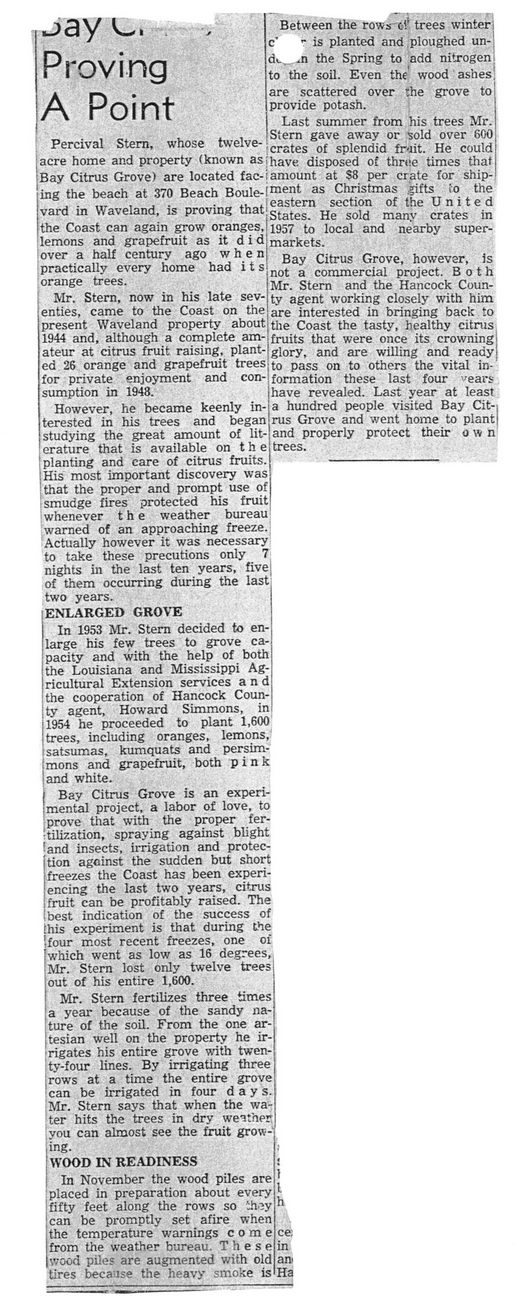This text was obtained via automated optical character recognition.
It has not been edited and may therefore contain several errors.
^ay^. Proving A Point Percival Stern, whose twelve-:acre home and property (known as 'Bay Citrus Grove) are located fac-jing the beach at 370 Beach Boule-ivard in Waveland, is proving that i the Coast can again grow oranges, lemons and grapefruit as it did over a half century ago when practically every home had its orange trees. Mr. Stern, now in his late seventies, came to the Coast on the present Waveland property about 1944 and, although a complete amateur at citrus fruit raising, planted 26 orange and grapefruit trees for private enjoyment and consumption in 1948. However, he became keenly interested in his trees and began studying the great amount of lit-' erature that is available on the planting and care of citrus fruits. ;His most important discovery was that the proper and prompt use of smudge fires protected his fruit whenever the weather bureau warned of an approaching freeze. Actually however it was necessary to take these precutions only 7 nights in the last ten years, five of them occurring during the last two years. ! ENLARGED GROVE j In 1953 Mr. Stem decided to enlarge his few trees to grove capacity and with the help of both ! the Louisiana and Mississippi Agricultural Extension services and the cooperation of Hancock Counity agent, Howard Simmons, in 11954 he proceeded to plant 1,600 'trees, including oranges, lemons, isatsumas, kumquats and persim-Imons and grapefruit, both pink 'and white. I Bay Citrus Grove is an experi-!mental project, a labor of love, to prove that with the proper fertilization, spraying against blight 'and insects, irrigation and protection agcinst the sudden but short i freezes the Coast has been experiencing the last two years, citrus i fruit can be profitably raised. The best indication of the success of !his experiment is that during the !four most recent freezes, one oi !which went as low as 16 degrees, Mr. Stern lost only twelve trees i out of his entire 1,600. ! Mr. Stem fertilizes three times a year because of the sandy nature of the soil. From the one artesian well on the property he irrigates his entire grove with twenty-four lines. By irrigating three ■rows at a time the entire grove can be irrigated in four days. Mr. Stern says that when the water hits the trees in dry weather you can almost see the fruit grow-; ling- WOOD IN READINESS j In November the wood piles are placed in preparation about every fifty feet along the rows so ih^y |can be promptly set afire when the temperature warnings come [from the weather bureau. These (wood piles are augmented with old tires because the heavy smoke is Between the rows t!* trees winter c’ - is planted and ploughed un-d«.. .n the Spring to add nitrogen to the soil. Even the wood ashes are scattered over the grove to provide potash. Last summer from his trees Mr. Stern gave away or sold over 600 crates of splendid fmit. He could have disposed of three times that amount at S8 per crate for shipment as Christmas gifts fo the eastern section of the United States. He sold many crates in 1957 to local and nearby supermarkets. Bay Citrus Grove, however, is not a commercial project. Both Mr. Stern and the Hancock County agent working closely with him are interested in bringing back to the Coast the tasty, healthy citrus fruits that were once its crowning: glory, and are willing and ready! to pass on to others the vital in-: formation these last four wears have revealed. Last year at least a hundred people visited Bay Cit-: rus Grove and went home to plant! and properly protect their own trees. 1 I h ce; in an Ha

Hancock County History General Newspaper Clippings Bay-Citrus-Grove